
Soustice feels like a mashup of so many different things. The environmental design is very clearly inspired by the original Dark Souls. The character design feels like a blend of Final Fantasy VII and the Clone Wars animated series, and the gameplay is heavily inspired by action hack-and-slash games like the Devil May Cry series. Oh, and there’s also 3D puzzle platforming.
With so much going on in this game, it really started to seem like something I’d just have to experience firsthand rather than piece together from all of the disparate scraps of information that have been revealed thus far. Thankfully, publisher Modus Games gave me a chance to do exactly that.

I attended a short-but-informative presentation via Discord, during which I was introduced to the game’s dual protagonists, Briar and Lute. Briar reminds me of a mix between Lightning from Final Fantasy XIII and Cloud from Final Fantasy VII, and she has an eyepatch. Lute is a childlike ghost who’s a little bit like a female version of Casper. In Soulstice, you play as both characters simultaneously (think Rosalina and Luma in Super Smash Bros.)
During the presentation, I was shown the opening chapter of the game, set in a dock area that reminded me a lot of the first part of New Londo Ruins in Dark Souls — there were a lot of chains and pieces of splintered wood, with a mist hovering above the dark water.
The demo build I played, however, starts after that point, in the game’s second chapter. This begins with our protagonists riding an elevator up to a new area, set atop a castle wall with wooden barricades and fire everywhere. This reminded me of the early section of Demon’s Souls where you’re approaching the castle for the first time, or parts of Stormveil Castle in Elden Ring. If you think I’m being a little heavy-handed with the FromSoft references, keep in mind that the team did cite FromSoft as one of their inspirations.
But that inspiration is mostly aesthetic — it can be seen in the background design and the choice of color, and can be heard in the ominous violin notes that create the game’s mood. Soulstice is not a Soulslike at all where gameplay is concerned, despite having the word Souls in the title.
So let’s talk about that gameplay! Note that I used an Xbox controller, so I’m going to explain the controls in those terms.
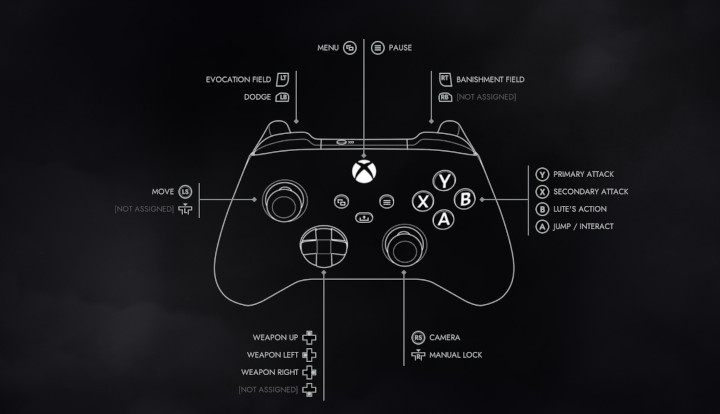
Briar starts out the demo with three weapons. The first one is mapped to Y, which is the primary attack button, and it’s a buster sword called the Ashen Vindicator. If I understand this correctly, this will be Briar’s primary weapon for the duration of the game.
The secondary weapon is mapped to X. By default (at least in this portion of the demo), this weapon slot is equipped with a hunk of welded-together metal shards that Briar swings like a battle-axe. This is called the Ashen Enforcer.
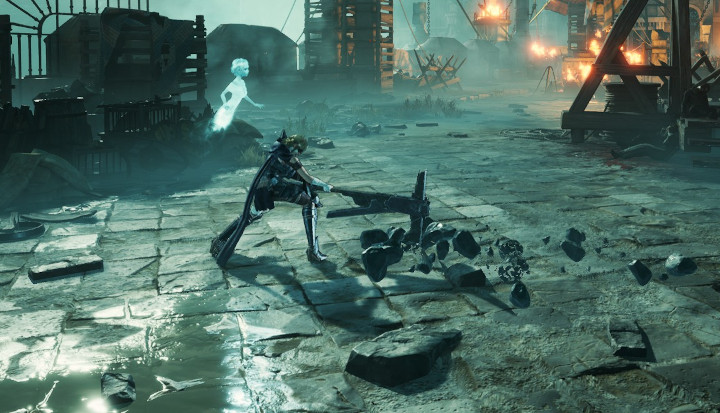
By pressing right on the D-pad, you can swap that out with the Tearing Penance, a whip that has extraordinary range. I found myself immediately drawn to this weapon, and it’s what I ended up using for most of my playthrough. It felt really satisfying to use, and the absurd range allowed me to keep my distance from enemies while still dealing damage.
At certain points in combat, I’d be given the option to have Lute perform a counterattack. This was signaled by a B-button icon over that enemy. If I timed the button press correctly, Lute would attack that enemy and freeze them briefly, allowing me to launch flurry of blows while the enemy was helpless.
While there are some enemies just ambling about, there are also sections where enemies come at you in waves. The edges of the battle space will then be blocked with a forcefield, and you must defeat all of the waves of enemies before you can progress any further. When you’re done with the fight, you’ll get a rating based on how long it took and how many combo multipliers you were able to achieve. The higher the rating, the more currency you earn for that battle.
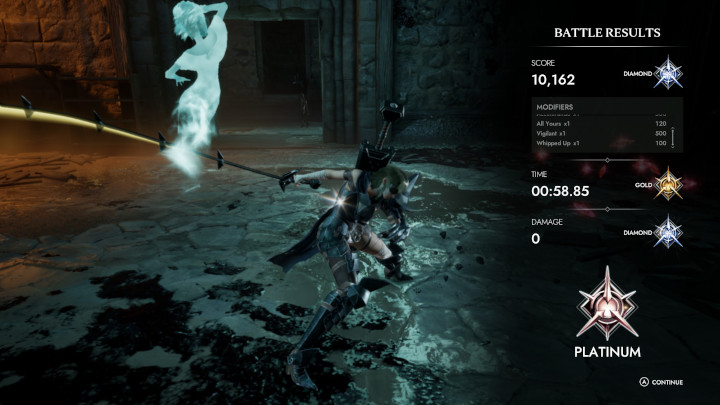
And speaking of currency…
As I was playing, I was earning two different currencies — one is represented by red crystals, the other by blue ones. The red crystals are much easier to acquire, as any normal enemy slain or wooden crate or barrel smashed would send those crystals clanking across the stone floor.
The blue ones, however, required me to find ethereal tears, which are shown as sort of blue blurs of energy that hover in the air. I could activate Lute’s Evocation Field (a blue forcefield) and the crystals would come into focus so long as they were inside that field. Then, I could smash those to add them to my collection. There are also huge versions of these crystals called motherlodes, which drop a whole ton of blue crystals.
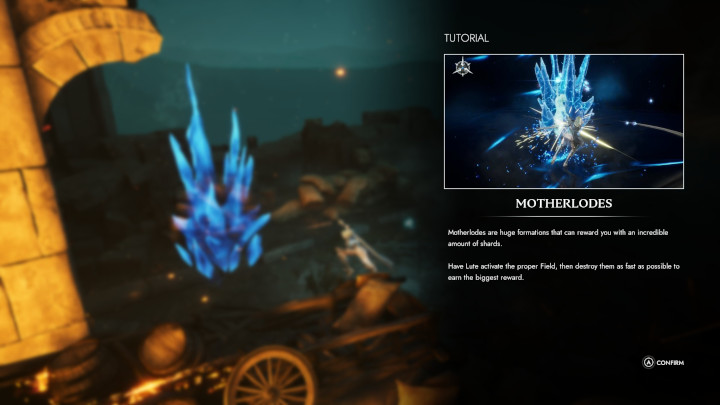
Later in the demo, there were enemies called Wraiths that could only be harmed while inside the Evocation Field, and those would drop blue crystals instead of red ones. There’s also a red version of the Evocation Field, called the Banishment Field, and that will allow you to attack large crystal formations that are red in color. Those, as you might guess, will drop red crystals.
So what can you do with these crystals? Well, you’ll meet a hooded character named Layton, who will let you spend them on upgrades. The red crystals are spent unlocking new attack combos for Briar’s weapons, while the blue crystals are spent on Lute’s skill tree, which is impressively robust. Lute has four skill tree categories (Offence, Field, Defense, and a fourth one that was locked in the demo), and each of them blooms outwards into dozens of possible nodes.
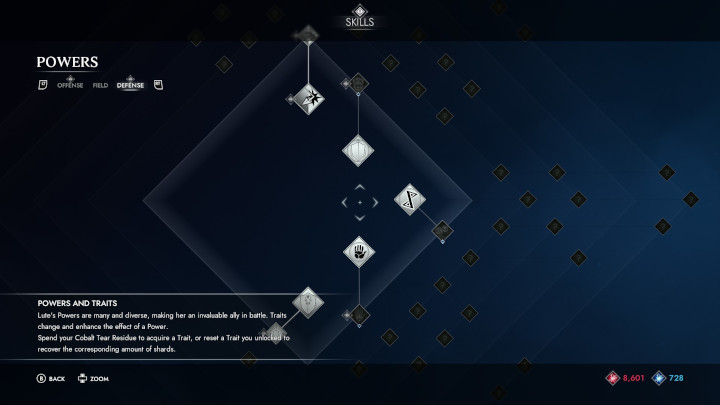
I was told that Layton would appear at specific locations in each chapter — I found him twice just in Chapter 2 — so you won’t have to hop to a different chapter just to spend your currency. Think of Layton as the game’s version of Dark Souls‘ bonfires (with the exception that you don’t drop your currency if you end up dying).
I played the first section of the demo, and then I decided to start over, so I used the “Restart” menu option. This brought be back to the very start of the demo and led me to an interesting discovery: I still had all of the currency I’d collected on my previous playthrough. I don’t think this was a bug; I believe this is how the game is supposed to work. That way, if you replay a chapter (the full game will allow you to replay any chapters you’ve already completed), you can earn more currency, giving you the option to grind lucrative parts of the game to earn enough currency to buy and enhance your skills.
Oh, and there’s a third type of crystal that will drop from crates and things, but it’s not a currency. These green crystals will refill your health bar.
I didn’t spend a ton of time with Soulstice quite yet, but what I’ve played so far is feeling really good. I can’t wait to play the full game when it launches September 20, 2022.